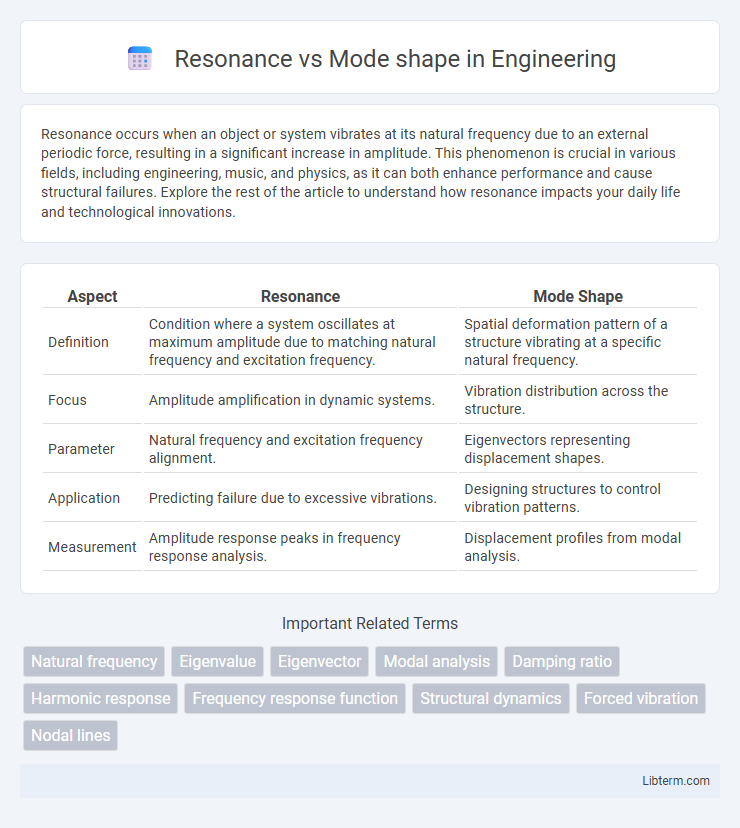Resonance occurs when an object or system vibrates at its natural frequency due to an external periodic force, resulting in a significant increase in amplitude. This phenomenon is crucial in various fields, including engineering, music, and physics, as it can both enhance performance and cause structural failures. Explore the rest of the article to understand how resonance impacts your daily life and technological innovations.
Table of Comparison
| Aspect | Resonance | Mode Shape |
|---|---|---|
| Definition | Condition where a system oscillates at maximum amplitude due to matching natural frequency and excitation frequency. | Spatial deformation pattern of a structure vibrating at a specific natural frequency. |
| Focus | Amplitude amplification in dynamic systems. | Vibration distribution across the structure. |
| Parameter | Natural frequency and excitation frequency alignment. | Eigenvectors representing displacement shapes. |
| Application | Predicting failure due to excessive vibrations. | Designing structures to control vibration patterns. |
| Measurement | Amplitude response peaks in frequency response analysis. | Displacement profiles from modal analysis. |
Introduction to Resonance and Mode Shape
Resonance occurs when a system vibrates at its natural frequency, leading to a significant increase in amplitude due to energy accumulation. Mode shape describes the specific pattern of deformation that a structure undergoes at each natural frequency during vibration. Understanding resonance and mode shapes is crucial in designing structures to avoid excessive vibrations and potential failures.
Defining Resonance in Structural Dynamics
Resonance in structural dynamics occurs when a structure's natural frequency matches the frequency of an external force, causing amplitude amplification of vibrations. Mode shapes represent the specific deformation patterns a structure undergoes at each natural frequency, revealing how resonance manifests spatially within the structure. Understanding resonance is crucial for predicting and mitigating excessive oscillations that may lead to structural failure.
Understanding Mode Shapes
Mode shapes represent the specific patterns of deformation that a structure undergoes at particular natural frequencies during vibration. Understanding mode shapes is critical for identifying points of maximum displacement or stress, which helps in designing structures to avoid resonant conditions that can cause failure. Analyzing mode shapes through techniques like finite element analysis or modal testing provides insight into how different parts of the structure interact dynamically.
Key Differences Between Resonance and Mode Shape
Resonance occurs when a system vibrates at its natural frequency, causing maximum amplitude due to energy buildup, while mode shape describes the specific pattern of deformation during vibration at each natural frequency. Resonance emphasizes the frequency response and the amplification effects, whereas mode shape focuses on the spatial distribution of displacement within the structure. Understanding resonance aids in predicting dynamic behavior and potential failures, whereas mode shape analysis helps in identifying vibration modes and designing for structural stability.
Physical Significance of Resonance
Resonance occurs when a system vibrates at its natural frequency, resulting in a significant increase in amplitude due to energy accumulation. The physical significance of resonance lies in its ability to amplify vibrations, which can lead to structural damage or failure if not properly controlled. Mode shapes describe the deformation patterns during vibration at specific frequencies but do not capture the amplitude amplification characteristic of resonance.
Importance of Mode Shapes in Engineering
Mode shapes are crucial in engineering because they reveal the specific deformation patterns of structures at natural frequencies, enabling accurate prediction of resonance conditions and potential failure points. Understanding mode shapes helps engineers design structures to avoid excessive vibrations that can resonate with operational forces, thereby enhancing safety and durability. This insight informs the optimization of materials and geometries in bridges, buildings, and mechanical systems to withstand dynamic loads effectively.
Resonance Frequency vs Mode Shape Patterns
Resonance frequency refers to the specific frequency at which a system naturally oscillates with maximum amplitude due to constructive interference, while mode shape patterns describe the spatial distribution of displacement during these vibrations. Each resonance frequency corresponds to a unique mode shape, defining how different parts of the structure move relative to each other. Understanding the correlation between resonance frequencies and their mode shape patterns is crucial for predicting structural behavior and avoiding resonance-induced failures.
Factors Influencing Resonance and Mode Shapes
Resonance occurs when a structure vibrates at its natural frequency, which depends on material properties, geometry, and boundary conditions. Mode shapes describe the specific deformation patterns at these natural frequencies, influenced by stiffness distribution and mass placement within the structure. Variations in material density, structural damping, and support constraints critically affect both resonance frequencies and corresponding mode shapes.
Applications in Structural Analysis
Resonance occurs when a structure's natural frequency matches the frequency of external forces, causing large amplitude vibrations that can lead to failure. Mode shapes represent the specific deformation patterns structures exhibit at their natural frequencies, providing critical information for identifying potential resonance issues. Engineers use mode shape analysis to predict structural responses and design reinforcements that mitigate resonance risks in buildings, bridges, and mechanical components.
Conclusion: Interrelation and Practical Implications
Resonance and mode shape are fundamentally interrelated, as resonance occurs when a system vibrates at a mode shape's natural frequency, amplifying displacement patterns distinct to that mode. Understanding this interplay is crucial for designing structures, machinery, or components to avoid destructive resonance by modifying mode shapes through stiffness or mass distribution alterations. Practical implications include enhancing safety, durability, and performance by predicting and controlling vibration responses in engineering applications.
Resonance Infographic

 libterm.com
libterm.com